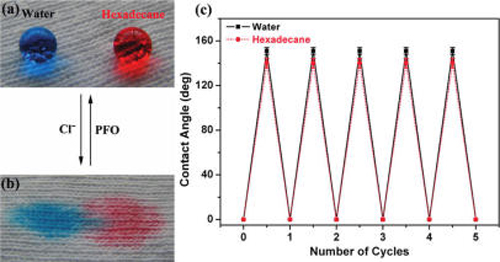Researchers at the R&D Center of Lubricating and Protecting Materials of the Lanzhou Institute of Chemical Physics have achieved the switchable hydrophobicity and oleophobicity on fabrics by counterion exchange.
A cotton fabric was sequentially dipped in the poly(diallydimethylammonium chloride) (PDDA) and poly(sodium 4-styrene sulfonate) (PSS) aqueous solutions to generate a re-entrant textured surface with a polyelectrolyte multilayer. Counterion exchange was used to control the surface composition and thereby to modulate the solid surface energy. The tunability of the solid surface energy, along with the inherent re-entrant texture of the cotton fabric, results in simultaneously switchable wettability between a nonwetting state and a fully wetted state for water and hexadecane.
This simple and novel technology for switchable hydrophobicity and oleophobicity could be applied to other reentrant structures on metal or inorganic substrates.
This work was has received support from the National Nature Science Foundation of China. The findings have been published in Langmuir (Langmuir 2011, 27, 7357–7360).
LangmuirPaper

(a,b) Water and hexadecane droplets on the polyelectrolyte deposited surfaces coordinated with PFO anions and Cl–, respectively. (c) Switchable hydrophobicity and oleophobicity of the polyelectrolyte deposited fabric with water and hexadecane via consecutive counterion exchange. (Image by ZHANG Zhaozhu et al.)
